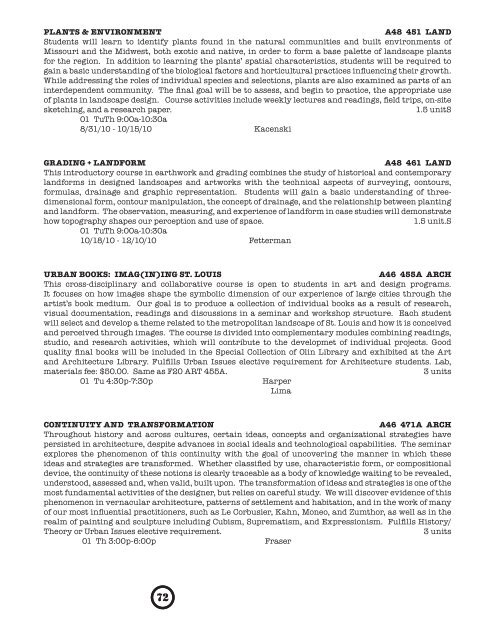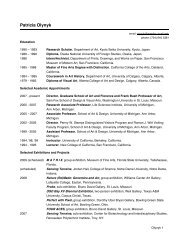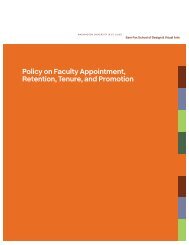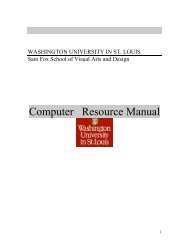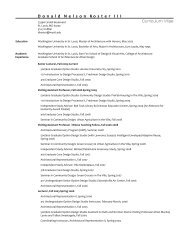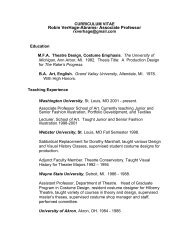architecture - Sam Fox School - Washington University in St. Louis
architecture - Sam Fox School - Washington University in St. Louis
architecture - Sam Fox School - Washington University in St. Louis
You also want an ePaper? Increase the reach of your titles
YUMPU automatically turns print PDFs into web optimized ePapers that Google loves.
PLANTS & ENVIRONMENT A48 451 LAND<br />
<strong>St</strong>udents will learn to identify plants found <strong>in</strong> the natural communities and built environments of<br />
Missouri and the Midwest, both exotic and native, <strong>in</strong> order to form a base palette of landscape plants<br />
for the region. In addition to learn<strong>in</strong>g the plants’ spatial characteristics, students will be required to<br />
ga<strong>in</strong> a basic understand<strong>in</strong>g of the biological factors and horticultural practices <strong>in</strong>fluenc<strong>in</strong>g their growth.<br />
While address<strong>in</strong>g the roles of <strong>in</strong>dividual species and selections, plants are also exam<strong>in</strong>ed as parts of an<br />
<strong>in</strong>terdependent community. The f<strong>in</strong>al goal will be to assess, and beg<strong>in</strong> to practice, the appropriate use<br />
of plants <strong>in</strong> landscape design. Course activities <strong>in</strong>clude weekly lectures and read<strong>in</strong>gs, field trips, on-site<br />
sketch<strong>in</strong>g, and a research paper. 1.5 unitS<br />
01 TuTh 9:00a-10:30a<br />
8/31/10 - 10/15/10 Kacenski<br />
GRADING + LANDFORM A48 461 LAND<br />
This <strong>in</strong>troductory course <strong>in</strong> earthwork and grad<strong>in</strong>g comb<strong>in</strong>es the study of historical and contemporary<br />
landforms <strong>in</strong> designed landscapes and artworks with the technical aspects of survey<strong>in</strong>g, contours,<br />
formulas, dra<strong>in</strong>age and graphic representation. <strong>St</strong>udents will ga<strong>in</strong> a basic understand<strong>in</strong>g of threedimensional<br />
form, contour manipulation, the concept of dra<strong>in</strong>age, and the relationship between plant<strong>in</strong>g<br />
and landform. The observation, measur<strong>in</strong>g, and experience of landform <strong>in</strong> case studies will demonstrate<br />
how topography shapes our perception and use of space. 1.5 unit.S<br />
01 TuTh 9:00a-10:30a<br />
10/18/10 - 12/10/10 Fetterman<br />
URBAN BOOKS: IMAG(IN)ING ST. LOUIS A46 455A ARCH<br />
This cross-discipl<strong>in</strong>ary and collaborative course is open to students <strong>in</strong> art and design programs.<br />
It focuses on how images shape the symbolic dimension of our experience of large cities through the<br />
artist’s book medium. Our goal is to produce a collection of <strong>in</strong>dividual books as a result of research,<br />
visual documentation, read<strong>in</strong>gs and discussions <strong>in</strong> a sem<strong>in</strong>ar and workshop structure. Each student<br />
will select and develop a theme related to the metropolitan landscape of <strong>St</strong>. <strong>Louis</strong> and how it is conceived<br />
and perceived through images. The course is divided <strong>in</strong>to complementary modules comb<strong>in</strong><strong>in</strong>g read<strong>in</strong>gs,<br />
studio, and research activities, which will contribute to the developmet of <strong>in</strong>dividual projects. Good<br />
quality f<strong>in</strong>al books will be <strong>in</strong>cluded <strong>in</strong> the Special Collection of Ol<strong>in</strong> Library and exhibited at the Art<br />
and Architecture Library. Fulfills Urban Issues elective requirement for Architecture students. Lab,<br />
materials fee: $50.00. <strong>Sam</strong>e as F20 ART 455A. 3 units<br />
01 Tu 4:30p-7:30p Harper<br />
Lima<br />
CONTINUITY AND TRANSFORMATION A46 471A ARCH<br />
Throughout history and across cultures, certa<strong>in</strong> ideas, concepts and organizational strategies have<br />
persisted <strong>in</strong> <strong>architecture</strong>, despite advances <strong>in</strong> social ideals and technological capabilities. The sem<strong>in</strong>ar<br />
explores the phenomenon of this cont<strong>in</strong>uity with the goal of uncover<strong>in</strong>g the manner <strong>in</strong> which these<br />
ideas and strategies are transformed. Whether classified by use, characteristic form, or compositional<br />
device, the cont<strong>in</strong>uity of these notions is clearly traceable as a body of knowledge wait<strong>in</strong>g to be revealed,<br />
understood, assessed and, when valid, built upon. The transformation of ideas and strategies is one of the<br />
most fundamental activities of the designer, but relies on careful study. We will discover evidence of this<br />
phenomenon <strong>in</strong> vernacular <strong>architecture</strong>, patterns of settlement and habitation, and <strong>in</strong> the work of many<br />
of our most <strong>in</strong>fluential practitioners, such as Le Corbusier, Kahn, Moneo, and Zumthor, as well as <strong>in</strong> the<br />
realm of pa<strong>in</strong>t<strong>in</strong>g and sculpture <strong>in</strong>clud<strong>in</strong>g Cubism, Suprematism, and Expressionism. Fulfills History/<br />
Theory or Urban Issues elective requirement. 3 units<br />
01 Th 3:00p-6:00p Fraser<br />
72


